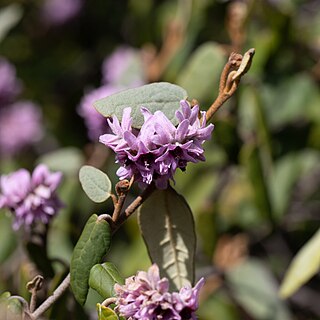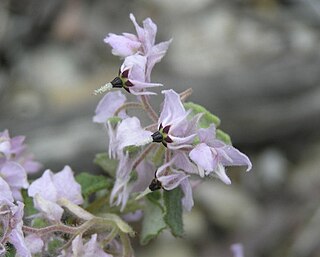
Lasiopetalum behrii, commonly known as the pink velvet bush, is a species of flowering plant in the family Malvaceae and is endemic to southern continental Australia. It is an erect shrub with lance-shaped, narrowly oblong to narrowly elliptic leaves and groups of white to pink and reddish-brown flowers.

Lasiopetalum floribundum, commonly known as free flowering lasiopetalum, is a species of flowering plant in the family Malvaceae and is endemic to the south-west of Western Australia. It is an erect or spreading shrub with hairy young stems, egg-shaped leaves and pale pink, mauve or white flowers.

Lasiopetalum macrophyllum, commonly known as shrubby velvet bush, is a species of flowering plant in the family Malvaceae and is endemic to south-eastern Australia. It is a shrub with egg-shaped to lance-shaped with rust-coloured hairs on the lower surface, and woolly-hairy, cream-coloured and reddish flowers.

Boronia granitica, commonly known as granite boronia, is a plant in the citrus family, Rutaceae and is endemic to a small area of eastern Australia. It is an erect shrub with many branches, compound leaves and pink, four-petalled flowers.

Lasiopetalum rufum is a species of flowering plant in the family Malvaceae and is endemic to the Sydney region of New South Wales. It is a slender, erect or diffuse shrub with linear leaves and small groups of reddish or pinkish flowers.

Commersonia corniculata is a species of flowering plant in the family Malvaceae and is endemic to the southwest of Western Australia. It is an erect to prostrate shrub with 3-lobed, egg-shaped leaves, and white to cream-coloured flowers.
Pultenaea baeuerlenii, commonly known as Budawangs bush-pea, is a species of flowering plant in the family Fabaceae and is endemic to a restricted area of New South Wales. It is a small, erect shrub with linear, cylindrical, grooved leaves, and dense groups of yellow and red flowers, sometimes with red markings.

Pultenaea glabra, commonly known as smooth bush-pea, is a species of flowering plant in the family Fabaceae and is endemic to eastern New South Wales. It is an erect shrub with glabrous stems, linear to egg-shaped leaves with a concave upper surface, and yellow to red and orange flowers.
Lasiopetalum adenotrichum is a species of flowering plant in the family Malvaceae and is endemic to the Fitzgerald River National Park in the south of Western Australia. It is an erect shrub with hairy foliage, narrow egg-shaped to lance-shaped leaves and groups of white to cream-coloured and dark reddish-purple flowers.

Lasiopetalum bracteatum, commonly known as Helena velvet bush, is a species of flowering plant in the family Malvaceae and is endemic to the south-west Western Australia. It is an erect, spreading shrub with egg-shaped leaves and loose groups pinkish flowers.
Lasiopetalum cardiophyllum, is a species of flowering plant in the family Malvaceae and is endemic to the south-west of Western Australia. It is an erect shrub with egg-shaped to heart-shaped leaves and groups of pinkish flowers.
Lasiopetalum compactum, is a species of flowering plant in the family Malvaceae and is endemic to the south-west of Western Australia. It is an erect shrub with leathery, narrowly oblong leaves and cymes of white to pinkish flowers.

Lasiopetalum discolor, commonly known as coast velvet-bush, is a species of flowering plant in the family Malvaceae and is endemic to coastal areas of southern Australia. It is an erect, spreading or sprawling shrub with hairy stems, oblong to egg-shaped leaves and pink or white flowers.

Lasiopetalum glabratum is a species of flowering plant in the family Malvaceae and is endemic to the south-west of Western Australia. It is an erect shrub with densely hairy young stems, egg-shaped leaves and pale mauve-pink reddish-purple flowers.
Lasiopetalum lineare is a species of flowering plant in the family Malvaceae and is endemic to the south-west of Western Australia. It is an erect shrub with densely hairy young stems, linear leaves and bright pink and dark red flowers.
Lasiopetalum longistamineum is a species of flowering plant in the family Malvaceae and is endemic to a restricted area of New South Wales. It is a spreading shrub with its branches densely covered with woolly, rust-coloured hairs and has egg-shaped leaves and woolly-hairy flowers.
Lasiopetalum monticola is a species of flowering plant in the family Malvaceae and is endemic to the south-west of Western Australia. It is an erect, slender or straggling shrub with densely hairy branchlets, leaves and flowers, egg-shaped leaves and pink, cream-coloured or white flowers.

Lasiopetalum oppositifolium is a species of flowering plant in the family Malvaceae and is endemic to the south-west of Western Australia. It is an open, erect shrub with rusty-hairy young stems, linear, narrowly elliptic or narrowly egg-shaped leaves and white, pink and dark red flowers.

Lasiopetalum rosmarinifolium is a species of flowering plant in the family Malvaceae and is endemic to the south-west of Western Australia. It is an erect or spreading shrub with hairy stems and leaves, linear leaves and white flowers.

Lasiopetalum rotundifolium is a species of flowering plant in the family Malvaceae and is endemic to the south-west of Western Australia. It is an erect to spreading shrub with hairy young stems, round leaves with a heart-shaped base, and pink and dark red flowers.













